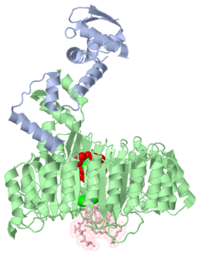Mechanism of Auxin Perception by the TIR1 ubiquitin ligase (2p1q)
Overview
. Auxin, shown here with green carbon atoms, is recognized by ARG403 (shown in blue) which forms hydrogen bonds with the acidic group. The aromatic portion of auxin is recognized by a pocket composed of hydrophobic amino acids, shown in white here.
Auxin promotes the association of TIR1 ubiquitin ligase with its protein substrates by acting as "molecular glue" between the molecules. This structure includes a short peptide from one of the protein substrates, shown here in pink in a or .
To see the similar interaction of the herbicide 2,4-D in this active site, see the entry for 2p1n.
Publication Abstract from PubMed
Auxin is a pivotal plant hormone that controls many aspects of plant growth and development. Perceived by a small family of F-box proteins including transport inhibitor response 1 (TIR1), auxin regulates gene expression by promoting SCF ubiquitin-ligase-catalysed degradation of the Aux/IAA transcription repressors, but how the TIR1 F-box protein senses and becomes activated by auxin remains unclear. Here we present the crystal structures of the Arabidopsis TIR1-ASK1 complex, free and in complexes with three different auxin compounds and an Aux/IAA substrate peptide. These structures show that the leucine-rich repeat domain of TIR1 contains an unexpected inositol hexakisphosphate co-factor and recognizes auxin and the Aux/IAA polypeptide substrate through a single surface pocket. Anchored to the base of the TIR1 pocket, auxin binds to a partially promiscuous site, which can also accommodate various auxin analogues. Docked on top of auxin, the Aux/IAA substrate peptide occupies the rest of the TIR1 pocket and completely encloses the hormone-binding site. By filling in a hydrophobic cavity at the protein interface, auxin enhances the TIR1-substrate interactions by acting as a 'molecular glue'. Our results establish the first structural model of a plant hormone receptor.
Mechanism of auxin perception by the TIR1 ubiquitin ligase., Tan X, Calderon-Villalobos LI, Sharon M, Zheng C, Robinson CV, Estelle M, Zheng N, Nature. 2007 Apr 5;446(7136):640-5. PMID:17410169
From MEDLINE®/PubMed®, a database of the U.S. National Library of Medicine.
About this Structure
2P1Q is a Protein complex structure of sequences from Arabidopsis thaliana. Full crystallographic information is available from OCA.


